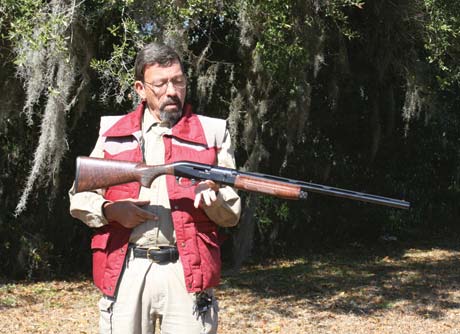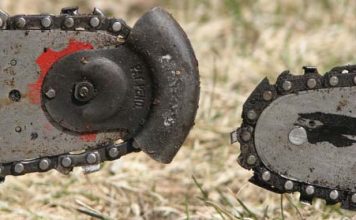 |
|
| Issue #120 • November/December, 2009 |
A year or more ago in these pages, I made the suggestion that sometimes less is more, and usually shooters with less powerful guns with which they are more skilled, will shoot better than if they had a bigger, more powerful firearm that kicked the heck out of them every time it went off. I haven’t changed my opinion in the intervening months, and I’d like to focus on the shotgun side of that.
The most popular shotgun in the United States, in the memory of any living American, has been the 12-gauge. It throws seven-eighths of an ounce to an ounce or more of lead, whether that heavy metal is distributed in tiny birdshot pellets, or big buckshot pellets, or the single humongous projectile that is known in the trade as a slug.
And, if you’ve ever shot one with a full-power shell in the chamber, you know that a 12-gauge kicks like heck. Guns which recoil that hard will, in turn, beat the heck out of the shooter and make them hesitant to pull the trigger. This leads to the phenomena firearms instructors refer to as “flinching” and “jerking,” convulsive body movements done in anticipation of pain and impact, which move the gun at the instant of firing and cause the shot to miss the target!
Now, I’m not a professor of logic or anything, but I have studied that discipline, and it’s part and parcel of what I have in fact taught for most of my life, which has been the use of things such as firearms in high stress situations. Math was never my best subject, but even I can figure out that a smaller charge of lead that hits will get a lot more accomplished on the business end than a larger serving of lead that misses the intended recipient.
|
The formulae I’ve been shown by the ammo companies I have dealt with for decades as one or another kind of gun editor for gun magazines show that the average 20-gauge shotgun load (five-eighths of an ounce of lead) will deliver to the shooter’s body via his or her shoulder only 55% of the recoil as a one-ounce charge of lead from a 20-gauge. Yet the lead delivered on target at the same velocity from a 20-gauge is 62.5% of the payload brought to impact by the one-ounce charge from a 12-gauge.
Did I mention math was my worst subject? OK…but even I can figure out that 55% of the debit in return for 62.5% of the credit is a 7.5% better deal.
Now, I’m not going to ask you to trade your 12-gauge for a 20-gauge for a 7.5% better return when you’re shooting. I’m not an investment counselor either, but if my financial advisor offered me a new plan that gave me 7.5% better return than what I was previously using I would run, not walk, to his office to sign up for the new deal.
Now, let me expand on that same analogy. Suppose that better investment plan also transferred to my spouse and my children, but the older investment plan only covered me. Would that change where I put my money? You bet, and I’m sure it’s the same for you.
I’m an average size adult male. I grew up shooting 12-gauge shotguns since I was a little kid, and that was the only type of shotgun available to me in 35 years in law enforcement, because the 12 had been the standard chambering for police shotguns since long before I was even born, and remains such. I’m comfortable with the 12-gauge. I’ve taken meat home with it. I’ve taken trophies home from matches with it. I’ve taken felons at gunpoint with it. But I’m also the prototypical adult male human that the 12-gauge shotgun was designed for, and I might not be the only one using the gun.
My little girls grew up discovering that they could shoot the 20-gauge a lot better than they could shoot the 12. My current consort is a petite female who loves to shoot her 20-gauge semiautomatic shotgun and hates to shoot any of my 12-gauges. Whether we’re going to the hunting field together or defending a household together, which would be the best choice for them to have available? Duh…let me think.
Versatility factor
Back in the 1950s, shotgun guru Francis E. Sell was the champion of the 20-gauge and led a renaissance of its popularity in the hunting fields. Yes, the lighter recoil was a factor, but more important to him seemed to be the fact that guns made for smaller cartridges were smaller and lighter themselves, and thus handled better. A light 20 swung faster on a flying bird than a heavier 12 of the same style, and even of the same make and model.
Sell did much to popularize the 3″ Magnum 20-gauge load. This came very close to a 12-gauge in pellet payload, and in power…and, unfortunately, in recoil. But there was still the smaller, lighter gun to swing on the fast-flying target and, therefore, better hit potential.
|
Francis E. Sell did a lot of “pass shooting”long range shots at high-flying ducks and geeseand he proved to the satisfaction of many that properly sized lead birdshot out of a 20-gauge Magnum would drop big waterfowl at reasonably long range as well as the universal standard 12-gauge. It’s an interesting historical artifact, but what changed everything was the long-ago switch away from lead that was legally
mandated for waterfowl hunting. Lead shot that missed the birds was said to be collecting at the bottom of the swamps and the rivers and the lakes, and killing other birds who ingested it. As soon as steel and other replacement shot came innot dense enough to penetrate deeply through the feathers and relatively tough flesh of ducks and geese, the way lead shot didit became a game of using enough big pellets to cleanly kill the birds with the new metallurgy of choice.
Thus came the return of the ancient 10-gauge Magnum, which in effect threw as many pellets with one pull of the trigger as a standard 12-gauge did with two. Thus came also the creation of the 3½” 12-gauge Magnum shell, which pretty much duplicated the payload of the giant 10-gauge. The much smaller 20-gauge, at that time, became pretty close to obsolete for use on ducks and geese.
So, let’s accept as a given for purposes of this article, that if waterfowl are on the family menu and thus one of the job descriptions of the family shotgun, the 20-gauge may not be the ideal choice. However, there are still upland birds such as pheasant and partridge. There is still small game such as rabbit and squirrel. With rifled slug loads, there is deer harvesting. And of course, there is home defense.
And for all of that, the easy-carrying, easy-handling, light-kicking 20-gauge seems to do just fine.
Rochester, Indiana. A petite young woman who grew up in the country aims carefully, presses the trigger of her shotgun, and sends a 20-gauge rifled slug through the chest of a large whitetail buck. The deer drops virtually in his tracks. There will be venison hanging to cure in the family barn tonight.
Bow, New Hampshire. The pheasant rises from the cornfield in a startling explosion of beating wings. A 20-gauge shotgun swings on the bird, and the proverbial shot rings out. Feathers puff away from the bird, which drops in a slow arc into the field. He will be the centerpiece of a New England family’s supper tonight.
Dade County, Florida. A bipedal predator strikes…and a law-abiding armed citizen decides not to be a victim. The victim presses the trigger of a 20-gauge shotgun, and the predator drops like the dead meat he has just become. His heart and lungs and aorta have been shredded, and some of the lead has reached through to the backbone and cut the spinal cord.
Venison on the table. Prime fowl on the table. Someone alive to sit at the table to eat with their family and partake of Nature’s bounty, when a monster might have kept that family from ever eating together again if his depredations had not been decisively stopped.
The 20-gauge shotgun can deliver all of that.
Choices
In past issues of Backwoods Home we’ve discussed the various types and mechanisms of guns, and the fact that you get what you pay for. That’s as true of the 20-gauge as it is of any other size of shotgun.
|
There are single shot shotguns, capable of firing only one time before they must be manually reloaded. In centuries past, that was all there was, and they sufficed as best they could. But if the first shot is a miss, and the second shot could be a hit, does it make any sense to eliminate the possibility of that next shot? This is why as soon as double barrel and, later, “repeating” shotguns became available, the single shot was deemed obsolete. They have remained in production primarily because they are the cheapest to manufacture for the entry-level market.
There are double barrel shotguns, which can be fired twice before reloading. In the game fields, many of us believe that if you can’t do it with two shots, you can’t do it at all, and hosing a flight of birds with shot pellets is more irresponsible than sportsmanlike. However, if your first shot has only wounded the bird and you have no other, you cannot fulfill your responsibility to your quarry to kill it cleanly, or your responsibility to feed your family tonight. Two months ago, on a clay target range in Orlando, Florida, I missed my first shot on the flying artificial “bird.” I shattered it with the second, triggered instantly from a Beretta semiautomatic shotgun. That’s the difference.
There are slide action shotguns, which require you to use your forward hand to pump the action mechanism back and then forward again, hence the terminology “pump gun.” They are rugged and low-maintenance and, in experienced hands, deadly fast. They can also hold as many shells as the tubular magazine under the gun’s barrel can be lengthened to hold, and they are cheaper than semiautomatics to manufacture. This is why they have so long been a staple with the police, the military, and the sportsmen, as well as those who live off the land. However, for rapid follow-up shots to be reflexive, the given shooter has to have a lot of experience operating that slide action. Competitive shooters get that experience. So do those of us who grew up running pump guns in the game fields. So do cops who are drilled with these guns over and over in the Police Academy. If you, or any member of your family who is likely to use the shotgun, haven’t had this movement pattern drilled into them, the pump gun may not be the best choice of the one shotgun to have available in the household.
Finally, there are semiautomatic shotguns, which use the force generated by the last shot’s discharge to cycle the next shotgun shell into the firing chamber. They can be fired as fast as the shooter can pull the trigger for each shot. Semiautomatics in turn branch into two mechanism types, gas-operated and recoil- or inertia-operated designs.
Let’s take a look at one for a moment…
One good example
I recently had the pleasure of spending several weeks with the new Benelli Ultra Light 20-gauge semiautomatic shotgun. If I was still the teenage kid I once was, who loved the upland game fields so much that after school I’d drive to the cornfields to hunt pheasant, I would have ponied up the $1529 for this splendid piece of sporting equipment in a New York minute.
This sweet little scattergun weighs only 5.2 pounds, which means that when you pick it up it feels as if it’s going to float out of your grasp. It balances sweetly between the hands, and experienced shotgunners describe it as “lively,” a term that in that context means that it swings effortlessly and points where you look. The trigger pull is clean and smooth.
It’s also a simply gorgeous firearm. The walnut stock is exquisitely burled, and covered with an invisible coating that Benelli calls Weather Coat™, and insists will not get waterlogged and warmed in the most drenching rain. The action runs as smooth as glass (forgive the cliché, but it’s true) as you chamber a shell from the magazine.
It’s not hard to disassemble, and it’s downright easy to clean. Benelli uses an action concept they call “Inertia-Driven.” Unlike gas-operated semiautomatics, which have tubes that channel the expanding gases of the rapidly-burning gunpowder back to the mechanism to cycle it, this system leaves most of the dirt and debris of carbon and unburnt powder in the barrel where it’s easy to swab out, instead of in the mechanism where it’s really a chore to clean.
|
This is not to say that the Ultra Light is the perfect shotgun. Lacking both a gas mechanism to cushion the recoil and weight mass to soak up the “kick,” it comes back on the shooter with a bit of a snap. In the excitement of dropping the bird that will be the centerpiece of tonight’s dinner table, this probably won’t bother you. Firing hundreds of rounds at a clay bird match or a shotgun training course may be a different story. The blue finish is lovely, the walnut “furniture” fore and aft is beautiful, but I noticed that the stock didn’t quite mate with the receiver (frame) in perfect harmony.
I could have lived with all that if I still hunted pheasants and partridges. But, I haven’t for decades. Each user’s needs determine the equipment he or she will choose. The one thing that kept me from buying this nice little Benelli was that to keep its weight as light as it is, the designers included a very short magazine tube and fore-end. This means it holds only three shells, two in the magazine and a third in the chamber, and my local gunsmith doesn’t see any way to extend that magazine.
That would be fine with me if I was looking for a pure sporting shotgun. For an all-around gun, whose total job description might include home defense, three shots is a bit on the short side. No police department ever trained its field troops better with shotguns than the LAPD, and on the street with their slide-action Ithaca Model 37s, that department’s cops amassed an impressive hit ratio of 58%. That is, roughly six out of ten of their shotgun blasts hit the violent, dangerous criminals those well-trained cops were aiming at.
Now, presume that you’re not as well-trained or as stress-inoculated as the average LAPD officer, and perhaps you’re facing three home invaders. In the county where I live, there has been a string of nine recent home invasions, all involving at least three perpetrators, probably from the same outlaw crew. Let’s see…three deadly targets that must be instantly neutralized…only one shot available for each…58% hit potential…carry the one…
Simple calculation tells me I want more firepower on hand if I have to point a shotgun at the door to “repel boarders” who represent an immediate threat of death or great bodily harm to me and mine.
Selecting the shotgun
If your only need for a shotgun is trap or skeet or sporting clays shooting, you can go in one direction. If your only need is home defense, you’ll probably end up going in a markedly different direction in your shotgun choice. And, if you’re not a “gun person” but just someone who loves the rural lifestyle and has decided that just one firearm is needed in the home, you might take a third tack.
Let’s look at the latter situation.
For the person who wants only one all-around shotgun, I would respectfully suggest a gas-operated semiautomatic 20-gauge. Yes, you’ll have to clean it more often, but if you live on a rural homestead, you’re already accustomed to taking care of your equipment, and each time you disassemble the gun as per the clearly written factory manual, you’ll become that much more familiar with it and, therefore, that much more comfortable with it.
The gas-operated semiautomatic is much softer kicking than any other shotgun type firing the same shell, for the simple reason that its gas-bleed mechanism that runs the firing cycle is diverting that much more impact away from the shooter’s shoulder. If you haven’t shot different types of shotguns of the same weight with the same shells, you really can’t appreciate how much “kick” the gas-operated semiautomatic soaks up with every shot fired.
The standard 2¾” 20-gauge shell, not the more powerful 3″ Magnum 20-gauge load that Francis Sell popularized, will send five-eighths of an ounce of lead out of the muzzle at 1400 to 1600 feet per second depending on the load and barrel length you’ve chosen. If you use a single rifled slug projectile, it will be about .62 caliber in diameter. That translates, basically, to shooting the target twice with a .44 Magnum in the exact same instant. Unless you have to shoot tiny pellets of steel instead of lead at a bird flying half a football field away, that’s the kind of firepower that gets the job done.
There are lots of good semiautomatic shotguns out there, chambered for the 20-gauge. My personal favorite is the gas-operated Remington, in the 1100 and 11/87 model series. The standard models come with five-shell capacity, four in the magazine and one more in the firing chamber. They also come with magazine plugs to bring the gun down to the same capacity you would have with that neat little Benelli, one in the launch tube and two more in the magazine. But that’s only required for waterfowl hunting, and as we’ve noted, that’s the one downside to choosing a 20-gauge in the time of steel and bismuth shot pellets being required for hunting waterfowl. Google “Brownell’s” and you’ll find lots of accessories, including extended magazines.
If you’re buying a “family shotgun,” which might be fired by Dad or Mom, by young Sis or young Bro, I would most strongly urge you to order the shotgun with a “youth stock,” designed to fit people of shorter stature with shorter arms. A shotgun with a long “pull,” which refers to the distance from gun butt to trigger, will be fine for a tall person with long arms…the sort of person that most guns seem to be built for. With smaller folks, these dimensions require them to lean back to hold the overly-long firearm steady. This takes them off balance for swinging on a moving target like a flying supper-bird, andmost seriouslyit makes the gun muzzle jump skyward with the recoil of every shot. This slows shot-to-shot time in delivering accurate hits. That’s the difference between a deer getting away or being consigned to the family larder today… and it can be the difference between stopping the second of two home invaders before he can murder the loved one who had to access the shotgun or not.
It is no trick for the larger person to shoot the shorter-stocked shotgun. That person simply pulls it tight into the shoulder and brings their eye closer to the sights. A short-stocked shotgun equals a gun the whole family can use very effectively. A long-stocked shotgun equals a firearm that only the taller, longer-armed members of the household can use with maximum efficiency, especially in an emergency.
It’s that simple.
|
Bottom line
The 20-gauge shotgun, particularly in the gas-operated semiautomatic version, seems to be one of the best-kept secrets in the firearms world. About the only thing it’s not very good for anymore, since heavy lead shot was legally forbidden for waterfowl hunting, is the harvesting of high-flying ducks and geese. In big bear country, I might also prefer the bigger slugs of a 12-gauge.
The 20-gauge will always “kick” less than the 12, and it will handle better and faster on quick-moving upland birds. With a buckshot load, the standard 20-gauge shell will fire 20 pellets of #3 buckshot (approximately .25 caliber), which will penetrate to about the same depth at about the same pattern width as the standard 12-gauge “urban load” of #4 buckshot, which comprises 27 pellets (about .23 caliber). The wound paths will be about the same depth and width, and the only difference will be how finely the macerated tissue has been chopped by the projectile paths. “Only the Medical Examiner will know for sure,” and then only when he counts the little lead balls recovered from the body, or the white dots on the X-ray of the corpse.
The 20-gauge shotgun. It is offered here for your consideration for the simple reason that it has compelling logic and a strong field history going for it.




















This was a well thought out well researched article written by an expert gun enthusiast. Very educational. A must read for anyone considering the trusty 20 ga.
I was raised on 20 gauge shotguns here in East Texas, killed many ducks, squirrels, Doves with 20 gauges, never owned a 12 or a 16. I currently have a Ithaca 37 featherweight, Franchi 48 , Winchester model 12, Remington model 11, Remington 870 Duck gun, Mossberg 500, and a Savage Fox double, also have reloaded my own shells for 40 years,
The 20 gauge is great. My father has an armsport over/under and I have a cz side/side. They are more fun to shoot trap or small game. We don’t have padded shooting jackets and 2 or more boxes of 12 gauge will beat you up. Years ago everyone shot 30/30 , 35 cal or 30-06 rifles. Now everyone you talk to buys 7mm mag , 338 win mag and so on. It is nice to read about fitting cal to what you are shooting. Thanks, Jimmy
Interested in 20 gauges . Semi-auto sounds grand as long as are reasonably priced. Thanks